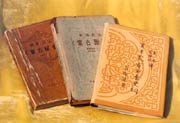|
Three Greatest Historical Works
 At the beginning of the 13th century, the Mongol Nationality created its own characters. After that, various kinds of works in history, literature etc. came out one after another, and some of them are even handed down to nowadays. The most famous ones are Mongol Secret History, Mongol Golden History, Mongol Headstream, which are called the Three Greatest Historical Works. At the beginning of the 13th century, the Mongol Nationality created its own characters. After that, various kinds of works in history, literature etc. came out one after another, and some of them are even handed down to nowadays. The most famous ones are Mongol Secret History, Mongol Golden History, Mongol Headstream, which are called the Three Greatest Historical Works.
Mongol Secret History is also called Yuan Dynasty Secret History, or Yuan Secret History, and in Mongol language, it is called "Manghuotaniuchatuobuchaan". The author is unknown. The book was finished around the middle period of the 13th century. As to the exact year, some say that it was finished in 1228 (Heavenly Stem Five, Earthly Branch One), and others say it was 1240 (Heavenly Stem Seven, Earthly Branch One), and still others say 1252 (Heavenly Stem Nine, Earthly Branch One) and 1264 (Heavenly Stem One, Earthly Branch One), but they haven't reached the last word. It is the first and greatest historical and literary work written in Mongolian. There are 282 sections in the book, which can be divided into 12 or 15 volumes. This chronological historical work vividly described all kinds of events happened on the Mongolian Grassland, including the moving legends of Genghis Khan, according to the oral stories of the Mongols which had been passed down generations. At the same time, it faithfully depicts the Mongol society, politics, economics, class relations, Genghis Khan's life story and historical facts during the rule of Wokuotai. The book fully acknowledges and highly praises the great achievement of Genghis Khan in unifying different tribes of the Mongol Nationality and pays a tribute to the newly established Mongolian nation. It is also contains invaluable data in studying the Mongol's early history, society, customs, language and literature, thus, it has been attached much importance by China and foreign scholars.
Mongol Golden History is also translated into Essentials of Mongol Golden History, Aletan Tuopuchi, to distinguish itself from Essentials of Golden History (author unknown), generally called Great Golden History. Mongol Golden History is chronological, and its author is a famous Mongolian scholar, Luobizangdanjin. The book was finished around the end of the Ming dynasty and the beginning of the Qing dynasty. It is a connecting link between the preceding and the following period and is a quite complete history of ancient Mongol. The book keeps a history of the Mongols from ancient times to the late Ming and the early Qing. The first part of the book re-records 233 sections out of Mongol Secret History's 282 sections, and renewed it with some history and events fore-and-aft the rise of the Mongol Nationality. The second half of the book makes use of books like Essentials of Golden History, and makes a thorough record and supplement on the Mongolian history from Wokuotai to the late Ming and the early Qing period. The book is rich in the Buddhism flavor due to the author's faithful belief in Buddhism. However, it is still regarded as an important work in studying the Mongolian history, especially that of the Ming dynasty.
Mongol Headstream, originally named Hadun Wenjiaosunu Eerdeni Tuopuchi, is a chronological history of the Mongol Nationality. The book was written in Mongol by Sanangchechen, who was an Ordos Mongol scholar, in the first year of Emperor Kangxi's reign (1662). Keerke Prince Chengyanzabu had presented the hand-written copy, which run in the family, to Qing Gaozong. The next year, it was translated into the Manchu language, and then into Chinese, and was named Mongol Headstream Authorized by the Emperor, and Mongol Headstream for short. There are 8 volumes in the book: the first two describe the general situation of Buddhism in India and Tibet; the rest volumes record the history of the Mongol nationality following the order of the era and the Mongolian descent. In writing this book, the author referred to 7 kinds of data both in Mongol and in Tibetan language, like Original Meaning of the Essential Sculptures, History of the Reign of Khans, Sublime Annulus Imperial Edict of Dharma History, Ancient History of Mongolian Khans and so on, and he also combined his own experience and knowledge in it. From the formation of the world, the origin and spread of Buddhism, to the origin of the Mongol nationality, the stories of the kings in Yuan and Ming dynasty, the book covers broadly. The narrations of Dayan Khan and Anda Khan are especially concrete. Although there are some eisegesis in the origin of the Mongol and also some mistakes in the events and years, the book is still considered as a great contribution to the study of Mongolian history, literature and religion, especially that of the Ming and Qing dynasty.
Andai, Handleless Cup and Chopsticks Dances
<<
Offer Sacrifices to Aobao
>>
|

